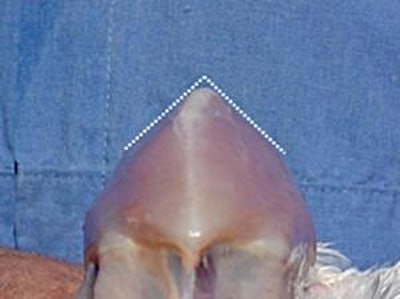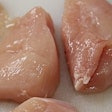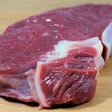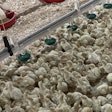
Persistency through lay is a key target in managing broiler breeder flocks for maximum output of hatching eggs. A good flock will maintain a high level of production after peak, and to achieve this requires starting the birds on the correct course from very early on.
The essential factor is flock uniformity. Feeding a group of chickens to meet the needs of the average bird inevitably undernourishes heavier birds and overfeeds lighter ones. The more uniform a flock, the more it can be fed to meet the needs of a greater proportion of birds and, just as importantly, feed can be reduced without accelerating the normal decline in production.
The best approach is to grade the birds during rearing. Recent experience in South America shows that grading by weight as early as seven days of age is beneficial. As frame size is established during the first five weeks, early grading, coupled with a second grading at four weeks, assures the best uniformity with each group fed to meet its specific needs. Additional grading by weight may need to be done at 8 and 12 weeks.
Uniformity as determined by weight will get worse as the flock is fed a limited amount to control weight, but since the frame size has been established, the uniformity will return as the birds are fed more to prepare them for light stimulation.
Grading by body composition can be performed at 16 weeks and just prior to lighting. If facilities are available, the groups can be separated in production houses according to their group weight and composition, and the birds fed into production and feed withdrawn properly.
Controlling body weight
In any growing program, there are critical points in achieving better persistency. Around 12 weeks, the weights need to be at the breed standard as the birds are just beginning to develop the reproductive system. In the period four to five weeks before light stimulation, body weight must be increased rapidly to prepare the birds to respond to the substantial increase in day length.
Then from light stimulation to onset of production, the weight must be controlled so birds begin to lay without being too heavy. From onset of production to peak, the weight must again be monitored to meet the breed criteria.
After peak production, persistency is almost totally dependent on proper weight control. It is tempting to ‘challenge feed’ a flock by giving a generous increase of feed for three to five days to try to stimulate higher production. This rarely works and ends up adding extra bodyweight to the hens, even accelerating the decline in production.
Checking body conformation
Although uniformity is the key to overall good performance, body conformation takes precedence over strict weight from 16 weeks to onset of lay. Two birds which weigh the same may be quite different in frame size, fleshing and fat reserves.
Weight uniformity may indeed be the worst at 16 weeks of age – as expected with the birds ending a period of stringent weight control. But if the frame uniformity has been established early on, the weight uniformity will return as the birds put on weight and mature. A grading at 16 weeks using body composition as a guide will allow the groups to be fed according to their individual needs for building fleshing and fat reserves before light stimulation. The breast fleshing should be the lowest in proportion to frame size at 16 weeks (a V shape) and progressing to a more rounded shape by 20 or 21 weeks.
The females should also be adding some limited amount of fat before the initial day length increase, as this is necessary to drive the reproductive hormones for developing the ovaries and building egg mass.
Feeding into peak production
After the flock has been exposed to the first and largest day length increase, feeding becomes important for weight control and resulting persistency. If the females have been fed properly before the day length increase, there will be some compensatory growth from the larger feed increases. Therefore, it is easy to overfeed from 21 weeks to onset of lay.
Smaller increases – just enough to meet the weight gain requirements – should keep the birds from gaining too rapidly. Similarly, the weight gain from onset (3% hen day production) to peak should be monitored and followed according to the breed recommendations. Too little gain will depress peak production, too much gain will make it harder to reduce the feed properly after peak.
Watch feed consumption time
Reducing the feed amount after peak production is vital, yet written programs tend to fall short with each flock unique in its requirements for achieving persistency. These factors need to be considered:
- Level of peak production: A flock peaking well may need the feed amounts reduced more slowly than a flock that has not performed well.
- Amount of peak feed: A flock peaking on 470 or more Kcals/hen/day can have the amount reduced more rapidly than a flock peaking on 440 or 450 Kcals.
- Weight of the hens: Is the average weight increasing, remaining the same or decreasing? Regular weighing will monitor the weight gain of the flock and assist in deciding how much to reduce the daily feed amount as production falls.
- Condition and body reserves: The hens must be handled often to determine if the composition is correct. Females can be checked to see if the fleshing is being maintained and the fat amount not becoming excessive.
- Feed consumption time: One of the most important and overlooked items where the birds can ‘tell you’ if the feed reduction is correct is the time needed to consume the daily ration. Less than 1.5 hours from start to clean-up may not be enough to satisfy all the hens. Conversely, feed in the system longer than four hours indicates the birds are getting more than they really need, and could soon become overweight which will harm persistency.
- Time of the year: Birds producing in less than ideal temperature conditions may require a bit more feed to maintain production. Hens will expend additional calories to keep warm if they are too cool or when panting to reduce their body temperature in hotter conditions.
Getting uniformity and weight control correct throughout the life of the flock not only maximizes production, but makes overall management much easier and more predictable. Your primary breeder technical adviser should be able to answer questions for specific flocks.


















